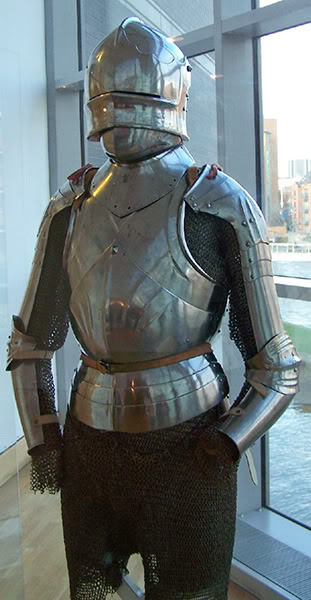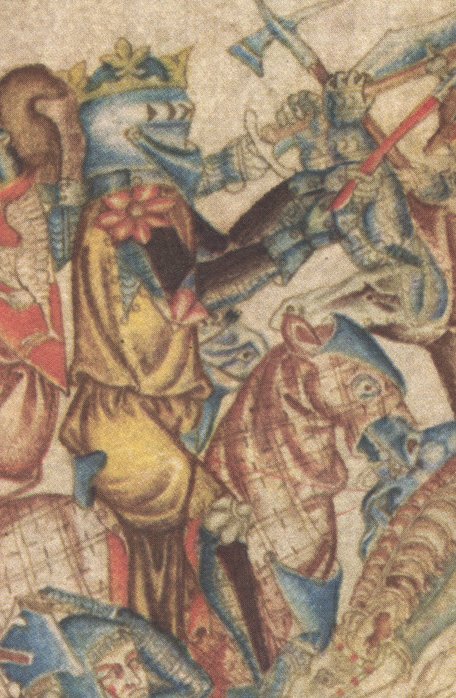So I've been on a early 14th century kick recently and was looking through the Gothic Eye website. (http://www.gothiceye.com/index.asp)
I came across some pictures I had seen before and found interesting. Instead of simply going "Hmmmm..." and moving on as I did previously, I thought I'd ask if anyone here had further information they might share.
Check out these two images of de Bacon and Sir William FitzRalph:
http://www.gothiceye.com/popup.asp?Ref=KN025
http://www.gothiceye.com/popup.asp?Ref=KN027
More specifically, look at their forearms. It looks to me like the plates are on the inside or upper part of the forearm. This seems rather odd compared to most forms of forearm defense. Does anyone know more about this? Is it some sort of artistical license or perspective error, or is it an "accurate" representation of actual armour? If it is supposed to represent actual armour, what is the intended purpose? (It seems odd from a foot combat perspective, but it occurs to me that holding a crouched lance might very well put the upper part of the forearm at risk and this armour might thus be specifically for such fighting. Can any jousters comment on this?)
Also, does it look to anyone else like Sir William has armoured straps holding his gutter pieces on? The straps are depicted in the same shade and appearance as the gutter pieces themselves...
These are not on the upper but on the outer side, just like on this armor
 .
.
Look where his hands are bent! Put you hands in the same position and you will see that what is the outer side of your forearms when you hold your hands in a natural position is now on top.
 .
.
Look where his hands are bent! Put you hands in the same position and you will see that what is the outer side of your forearms when you hold your hands in a natural position is now on top.
I personally think these are indeed on the upper side of the forearm.
When half-vambraces were worn, they seem to have been on the upper side of the forearm, and not the lower side like you see in the SCA. (Which actually makes much more sense to me)
They were likely pointed separately from the other pieces.
Wasn't sure if you'd seen these, but here are some more examples of the same thing.
http://effigiesandbrasses.com/monuments/roger...170/large/
http://effigiesandbrasses.com/monuments/hugh_.../12/large/
These seem to have been worn alongside closed vambraces/rerebraces for a while before completely disappearing.
When half-vambraces were worn, they seem to have been on the upper side of the forearm, and not the lower side like you see in the SCA. (Which actually makes much more sense to me)
They were likely pointed separately from the other pieces.
Wasn't sure if you'd seen these, but here are some more examples of the same thing.
http://effigiesandbrasses.com/monuments/roger...170/large/
http://effigiesandbrasses.com/monuments/hugh_.../12/large/
These seem to have been worn alongside closed vambraces/rerebraces for a while before completely disappearing.
I'm guessing "Artistic License" is the culprit. Looking at the whole picture I see quite anatomically wrong examples all over it.
I would also assume the artist wasn't an armourer.
My $.02
Murphy :cool:
I would also assume the artist wasn't an armourer.
My $.02
Murphy :cool:
Sir Hugh Hastings shows a lot more anatomical shaping http://effigiesandbrasses.com/monuments/hugh_.../12/large/. This support that this is real feature of some armour at this time.
As an aside: Over hand blows, fendenti and such, tend to be harder then a blow that come from below, Sottani
and such, so it makes sense to armour the top of the forearm with plate.
mackenzie
As an aside: Over hand blows, fendenti and such, tend to be harder then a blow that come from below, Sottani
and such, so it makes sense to armour the top of the forearm with plate.
mackenzie
| Mackenzie Cosens wrote: |
| Sir Hugh Hastings shows a lot more anatomical shaping http://effigiesandbrasses.com/monuments/hugh_.../12/large/. This support that this is real feature of some armour at this time.
As an aside: Over hand blows, fendenti and such, tend to be harder then a blow that come from below, Sottani and such, so it makes sense to armour the top of the forearm with plate. mackenzie |
His vambraces themselves also look to have a tulip shape.
I've never understood why when people try to reproduce these, they always wear them in line with the couter.
In the famous image from the Holkham Bible the king appears to be wearing similar half-vambraces.
When I use to play SCA I occasional get hit in the bottom forearm when I attacked, in part because the sword technique I was using had the forearm lead the sword. This made the bottom of the forearm a target for a stop-hit so it makes sense to armour bottom for the forearm. With the more historic sword play I now do, the sword leads the blow not the arm, so the bottom of the forearm is a less available target.
mackenzie
 Attachment: 95.58 KB
Attachment: 95.58 KB

Holkham Bible King
| Jojo Zerach wrote: |
| ...
When half-vambraces were worn, they seem to have been on the upper side of the forearm, and not the lower side like you see in the SCA. (Which actually makes much more sense to me) ... |
When I use to play SCA I occasional get hit in the bottom forearm when I attacked, in part because the sword technique I was using had the forearm lead the sword. This made the bottom of the forearm a target for a stop-hit so it makes sense to armour bottom for the forearm. With the more historic sword play I now do, the sword leads the blow not the arm, so the bottom of the forearm is a less available target.
mackenzie

Holkham Bible King
Try putting your hands into the position seen on the effigy. You'll find your outer forearms face upward, and the artist is portraying the half that remain towards the viewer. This issue occurs with the twisting motion your arm does when assuming this position. I can see how the positioning could fool your eyes though.
Page 1 of 1
You cannot post new topics in this forumYou cannot reply to topics in this forum
You cannot edit your posts in this forum
You cannot delete your posts in this forum
You cannot vote in polls in this forum
You cannot attach files in this forum
You can download files in this forum
All contents © Copyright 2003-2006 myArmoury.com — All rights reserved
Discussion forums powered by phpBB © The phpBB Group
Switch to the Full-featured Version of the forum
Discussion forums powered by phpBB © The phpBB Group
Switch to the Full-featured Version of the forum